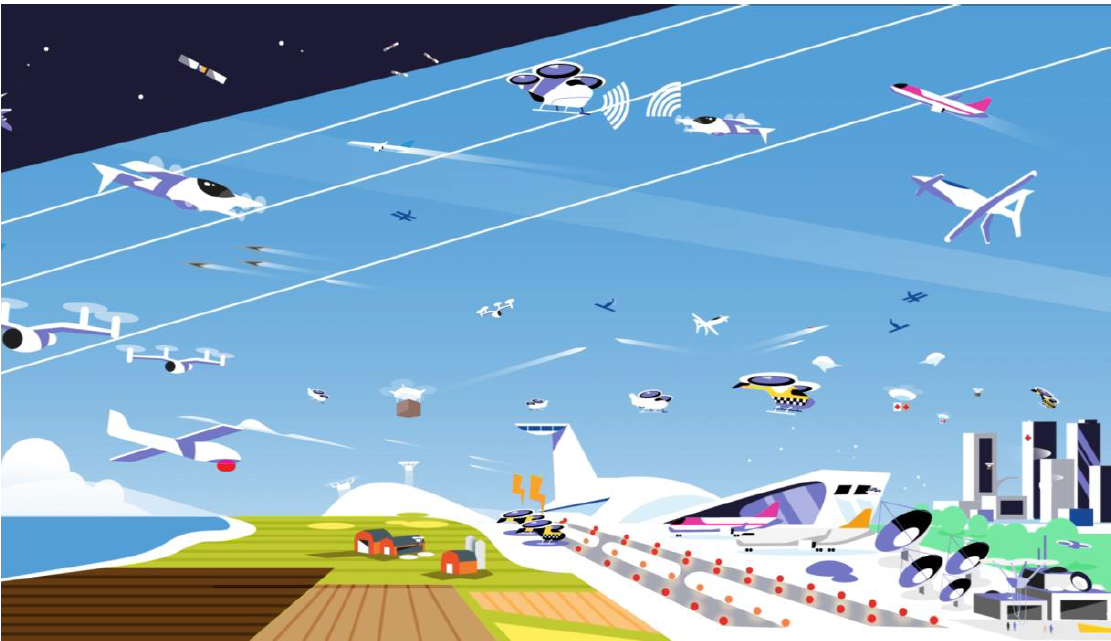Complete Air Traffic System (CATS)
Global Council News

In a unique collaboration, global leaders from more than 25 aviation and aerospace organisations have come together to create a vision for the skies of 2045 and beyond. The Complete Air Traffic System (CATS) Global Council, a forum of industry bodies, believes that a shared blueprint and joint action are vital to make sure that future skies are efficient, clean and safe and can generate global economic prosperity and social welfare. Imagine the airspace of 2045 – maximised to its fullest potential as a global resource; a unified, optimised, sustainable and safe environment where people and goods move effortlessly in a mix of manned and unmanned vehicles; a smart and connected network that is resilient and scalable; a healthy and competitive marketplace with a proud culture of innovation and agility; an industry that is thriving with a new generation of highly skilled talent. Over the next two decades, extensive and collective changes must be made to make this vision a reality. The following future-facing features are critical to achieve the fully integrated and harmonised airspace system the industry aspires to: Design and delivery of services that are truly user-centric so they can be equitable, scalable and resilient Capitalising on advances in information management, automated technology, digitisation, data-based services and connectivity for new, improved and safe services and increased productivity and growth Developments in hybrid technology, cleaner fuels, electrification, carbon capture, flight path optimisation and airspace design to improve the environmental sustainability of the industry and help countries achieve their climate targets Digitisation of the infrastructure of cities to allow aviation operators to create interconnected transport networks, including air taxis and drones Airspace to be reconfigured with a more flexible and dynamic cross-border service provision Investment in learning and development to make aviation accessible to a more diverse range of highly skilled talent Simon Hocquard, Director General, The Civil Air Navigation Services Organisation (CANSO) said: “We need to drive the next era of aviation in which the speed of change and rate of innovation will be faster than they have been for decades. Vision 2045 allows us to explore, imagine and shape a blueprint for how our global skies can innovate and interoperate safely in the future. “We have an opportunity to build a digital and automated regional transport network which is highly connective, safe, seamless and sustainable and that works for everyone. The future skyscape is just on the horizon. By working together, our vision of what is possible can and must become a reality.” Supporting statements Hugues de Beco, ATM programme manager, Airbus: “The unprecedented acceleration of technologies and the introduction of new types of airborne vehicles, equipment and services will trigger significant evolutions for aviation in the decades to come. Our collective duty to realise citizens’ expectations and our industry commitment to decarbonise will also accelerate significant changes in the way aviation and air traffic management operate.” Alex Bristol, CEO, Skyguide: “This vision is forward-looking, wide-reaching and ambitious in its scope. It creates a coherent possible picture of our future and places protection of the environment in a central position.” Luis Felipe de Oliveira, Director General, Airports Council International (ACI) World: “Airports are critical parts of the air traffic management network and need to be fully integrated within the global aviation system. Building a common vision is vital to creating a sustainable and resilient sector for the long term. It has allowed a collaborative and representative coalition of stakeholders to align on the future of the air transport system.” Guenter Graf, VP New Business Development, Frequentis: “We are excited to work together on a vision based on the convergence of safety, new technologies and innovation, all powered by the brightest minds. This vision will propel us towards a green aviation future as part of an interconnected transport system. With this we can make a change for a better tomorrow.” Arie Herweijer, Managing Director, AeroConnect: “The CATS Global Council is a unique initiative that, in this vision, has brought together a group of people from all continents collaborating towards the safe and efficient use of all airspace.” Huazhi Hu, Founder, Chairman and CEO of EHang: “We are excited to join hands with partners in the aviation industry to create global airspace that is safe, fair and intelligent, leveraging revolutionised design, technology and services to power global mobility and prosperity. We will support this vision to enable safe, autonomous and eco-friendly air mobility for everyone.” Parimal Kopardekar, Director of NASA Aeronautics Research Institute, NASA: “At a time when our current air transportation system is at its peak and with emerging technologies and new entrants coming into the airspace, we must have future air transportation systems ready and capable of handling new users in an efficient, safe, scalable and sustainable manner.” Patrick Ky, Executive Director, European Union Aviation Safety Agency (EASA): “Aviation is on the brink of major change with sustainability, technical advancement, digitalisation and new aircraft all acting as catalysts. With so many elements driving this change, it’s important that we have a shared vision for how aviation will look 25 years from now and a roadmap for getting there. Safety must remain a top priority throughout; on this point, citizens will not accept compromises.” Richard Parker, CEO, Altitude Angel: “Aviation is at its best when it’s pioneering, when it reaches out and touches our lives in ways the world has never seen before. This is precisely what our vision for 2045 will do, if we do it properly, at scale. It’s part of my mission to empower the industry with technologies to open the skies to this next wave of traffic. Aviation connects, we should always remember this.” Todd Sigler, Senior Director, Global Safety and Regulatory Affairs, Boeing: “As our industry is complex, it’s crucial that we have a common vision to work towards. This vision is rooted in safety and brings to light elements including efficiency, sustainability, interoperability and workforce. None of us can do this alone.”

The Complete Air Traffic System (CATS) Global Council had its inaugural meeting on 11 March 2021 to discuss the goals and expectations for the group in developing an aspirational vision for safely integrating all airspace users into future skies. A vision that all aviation actors can coalesce around. The CATS Global Council Membership is an independent forum which was initiated by the Civil Air Navigation Services Organisation (CANSO) and is founded on the principles of cooperation and leadership. All Council Members share a concern for the future of aviation and play leadership roles in key organisations in the aviation and aerospace sectors. “The first meeting of the CATS Global Council marks a critical step to shape a shared vision for how our global skies can innovate and interoperate safely in the future,” said CANSO Director General, Simon Hocquard. “I’m proud that we’ve assembled an incredible group of industry leaders who understands the importance of collaborating to forge a more adaptable, resilient and digital Air Traffic Management (ATM) system and integrate all airborne vehicles safely, efficiently and sustainably”. “How do we march into the future? How do we capitalise on the big and exciting opportunities in front of us? Now is the time to act and the formation of this Global Council is an important first step,” added Richard Parker, CEO, Altitude Angel . “What we’re doing hasn’t been done before, so we don’t have all the answers and that’s OK. This Council is a great opportunity for us to learn from one another and focus on the problems we need to solve today while creating a future framework that will enable innovation,” said Margaret Nagle, Head of Policy and Government Affairs, Wing. “This Council can play a crucial role by bringing different people and domains together. Achieving our long-term vision can’t happen overnight and preserving the safety and efficiency of existing operations is essential. It needs to be a carefully coordinated journey with the input of traditional players, building on the lessons learnt of more than 100 years of aviation experience, as well as exciting ideas from new entrants” said Todd Sigler, Senior Director for Global Safety and Regulatory Affairs at Boeing . “Today we have a fragmented system. Each party is strong in its own role yet there is no real cohesion and coordination in our activities. Our aim in the Global Council is to agree a common vision of the future, to understand what we want to, and need to, achieve together. But it’s not just about a vision. This is a call for action to all of us and a starting point for the work that must follow,” added Patrick Ky, Executive Director, European Union Aviation Safety Agency . “With this Council we have a unique opportunity to come together as a key driving force of the aviation ecosystem, take ownership and propose an agenda of radical change,” Jean Ferre, General Manager & Vice-President Airspace Mobility Solutions at Thales commented. “This Council will play an important, complementary role of convening folks from different domains so that we can collectively explore the challenges our industry faces and solve them effectively together,” said Bill Goodwin, Deputy General Counsel, Policy and Regulatory, Joby Aviation .

